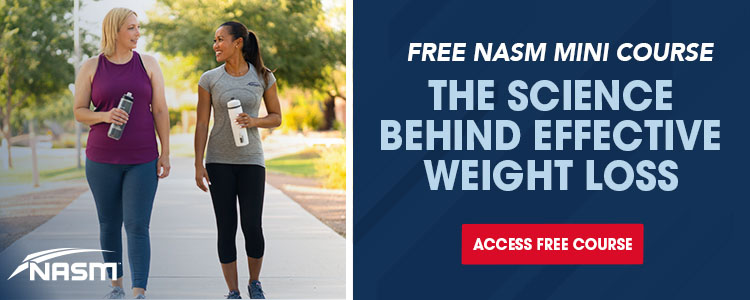BYJACQUELINE KAMINSKI
What is the most effective way to calculate caloric expenditure from physical activity? Well, unless you are in a research lab and have access to a metabolic cart, you will never get an exact value.
However, we are in luck! Physiologists have devised a way to estimate caloric expenditure for those of us that don’t have access to fancy equipment, and that’s by using metabolic equivalents!
Free weight loss mini course and calculator tool! Metabolic equivalents go hand-in-hand with weight loss. If you want a couple of free resources to help you on your weight loss journey, check out the NASM Calorie Calculator or our free weight loss course.
WHAT ARE METABOLIC EQUIVALENTS?
Metabolic equivalents are defined as caloric consumption (by means of breathing) of an active individual compared with their resting basal metabolic rate. It is based on how much oxygen the body consumes during activity compared to how much oxygen the body consumes at rest.
Most individuals at rest utilize 3.5mL of oxygen per kg of body weight per minute, which equates to 1 kcal/kg/hr. However, you should note that this value was pre-determined by testing on a 40-year-old man weighing 70kg. More recent studies show that true resting MET values are much lower than 3.5mL/kg/min and that age, gender, body fat, muscle mass, and illness significantly affect this value. However, this equation is used to provide people with estimates.
Therefore, we will assume 1 MET is the equivalent to a Vo2 (a measure of oxygen consumption) of 3.5mL/kg/min (resting state) and is equal to burning 1 kcal/min. If something requires 2 METS, then it requires twice the resting metabolism. When performing exercise, MET values are assigned to various forms of physical activity to determine how many calories are expended during that activity.
METABOLIC EQUIVALENTS CHART
Below are some common MET values associated with various activities based on the compendium of physical activities tracking guide:
| Heading | Description | METS |
| Bicycling | <10 mph, leisure, for pleasure | 4.0 |
| Bicycling | 10-11.9 mph, light effort | 8.0 |
| Bicycling | 12-13.9 mph, moderate effort | 10.0 |
| Bicycling | 14-15.9 mph, racing or vigorous effort | 12.0 |
| conditioning exercise | calisthenics (e.g., pushups, situps, pullups, jumping jacks), heavy, vigorous effort | 8.0 |
| conditioning exercise | calisthenics, home exercise, light or moderate effort, general (example: back exercises), going up & down from the floor | 3.5 |
| conditioning exercise | circuit training, including some aerobic movement with minimal rest, general | 8.0 |
| conditioning exercise | weight lifting (free weight, nautilus, or universal-type), powerlifting or bodybuilding, vigorous effort | 6.0 |
| conditioning exercise | stretching, yoga | 2.5 |
| conditioning exercise | water aerobics, water calisthenics | 4.0 |
| home activities | cleaning, light (dusting, straightening up, changing linen, carrying out the trash) | 2.5 |
| Walking | 3.5 mph (briskly & carrying objects less than 25 lbs) | 4.5 |
| Walking | < 2.0 mph (strolling, very slow) | 2.0 |
| Swimming | Swimming laps (freestyle, slow, moderate, or light effort) | 7.0 |
| Running | 5 mph (12 min/mile) | 8.0 |
| Running | 7 mph (8.5 min/mile) | 11.5 |
| Running | 10 mph (6 min/mile) | 16.0 |
| Sports | Basketball, non-game, general | 6.0 |
| Sports | Boxing, in the ring, general | 12.0 |
| Sports | Football, touch, flag, general | 8.0 |
| Sports | Golf, general | 4.5 |
| Sports | Tennis, general | 7.0 |
In the list, you will notice that some activities repeat but with different MET values. Some activities such as household chores, walking, leisure sports play, etc., can’t be directly classified for output but instead are assigned values based on the rating of perceived intensity. Therefore, many of these activities will show light, moderate, or heavy/vigorous descriptions next to it, along with its associated MET value.
In order to develop cardiorespiratory fitness, speed up metabolism, and enhance physical fitness levels, it is generally recommended that exercise should require 5-8 METS to provide a sufficient training stimulus. For trained individuals, activities requiring 8 METS or more may be required to provide a similar training stimulus.
HOW TO CALCULATE METABOLIC EQUIVALENTS
So now that we understand what metabolic equivalents are, how do we calculate them?
To determine calories expended by your favorite activity use the following equation:
METS X 3.5 X BW (KG) / 200 = KCAL/MIN.
For example, if a 30-year-old man weighing 170lbs (77.3kg) performs 45 minutes of running at 7mph, the amount of calories he would burn per minute would be:
11.5(3.5)(77.3kg)/200 = 15.6 kcals/min
So in 45 minutes, this man would burn 700 calories running at 7mph.
METS should not be confused with NEAT or non-activity thermogenesis. METS are associated with planned, deliberate exercise where NEAT is the cost of energy involved in spontaneous activity.
Remember, these equations only provide us with estimates of how many calories we expend during various activities. How many calories you burn daily at rest and during exercise vary largely based on gender, age, height, weight, and lean body mass. However, it’s always helpful to know how much energy you expend so you can fuel yourself appropriately!
SOURCES
https://prevention.sph.sc.edu/tools/docs/documents_compendium.pdf
https://onlinelibrary.wiley.com/doi/pdf/10.1002/clc.4960130809
https://journals.physiology.org/doi/full/10.1152/japplphysiol.00023.2004
https://www.sciencedirect.com/topics/medicine-and-dentistry/metabolic-equivalent
https://www.acefitness.org/education-and-resources/professional/expert-articles/6434/5-things-to-know-about-metabolic-equivalents/
PREVIOUS POST
CAN FOODS BOOST TESTOSTERONE FOR MEN AND WOMEN?
NEXT POST
POSTPARTUM WEIGHT LOSS: 10 THINGS YOU NEED TO KNOW
THE AUTHOR

JACQUELINE KAMINSKI
Jackie Kaminski is a registered dietitian/ nutritionist with a Master’s degree in Exercise Physiology & Sports Nutrition from Florida State University. Her first introduction to working with professional athletes was back in 2017 when she worked at the UFC performance institute in Las Vegas, Nevada. Since then, Jackie has worked with various professional fighters and other clientele and now operates under her company she started back in March, The Fight Nutritionist LLC. The Fight Nutritionist is dedicated to providing the most effective nutrition plans to ensure her athletes are performance at their absolute best. All of her plans are individualized to the athlete and are backed by the latest research to ensure complete safety and efficacy. Jackie is also a member of the international society of sports nutrition, where she often participates in different research projects and data collection with other ISSN members from Nova University. When Jackie isn’t working, you can find her at Combat Club where she trains kickboxing and Muy Thai. As a sports dietitian, Jackie’s aim is to provide her athletes with the necessary fuel to excel in training and provide the proper education to ensure her athletes are engaging in the safest health practices (as they relate to combat sports).



